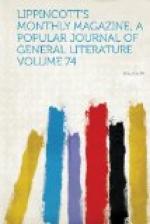We Americans generally bring total want of preparation with us from home: pictures and statues, their subjects and their authors, except a few of the most famous, are equally unknown to us. This is to some degree our own fault. All that we can learn by reading is valuable. I do not refer to criticism or descriptions, but what may be called the general literature of art—the lives of artists, the history of the various schools, even mythology and the lives of the saints; which last were the favorite theme during the best period everywhere except in England, whose native art is not much over a century old. This is within the reach of every one on this side the Atlantic, and to know what a picture is about is to have one source of confusion removed. Besides which, all accessory information adds much to the general interest and is a help in the first stages. Criticism is to be excepted, as tending to disturb the integrity of one’s individual impressions, difficult enough to keep independent under the influence of a great name. The beginner ought not to seek the opinion of others—except in devoting his attention to the works of highest fame, which is following the verdict of the world, and not of a person or set—until he has one of his own, always bearing in mind that his is probably wrong, and keeping his conceit down and his mind open to conviction. The study of works of art with the handbooks of connoisseurs belongs to the higher branches of aesthetic education, of which I have naught to tell.
Besides reading, of course all opportunities of seeing good specimens at home should be made the most of. These are far from so rare as ten years ago. In Boston the Athenaeum, in New York the Metropolitan Art Museum, and both in the latter city and Philadelphia the private collections—which the kindness of their owners makes almost as accessible as public ones—afford us examples of most contemporary painters and of some of the older masters; while our schools of design are provided with casts from the most celebrated antique statues, and many of the best modern ones come to our shores. The Arundel Society of London publishes chromo-lithographs of uncommon merit after the finest and most curious paintings of the Old World. But the best preparation of all is a knowledge of drawing: even if nothing is acquired beyond the ability to copy a cast correctly or sketch a landscape roughly but faithfully, it is a long step over the primary difficulties of the path.
The very first of these difficulties is to know what we really like. It is probably impossible to look at a famous work with eyes clear from preconceived impressions: copies, engravings, photographs, have familiarized us in some measure with the finest things in the world. However imperfect an idea may be given by reproductions of great pictures—great in size as well as merit—whether we have seen a Marcantonio or a Raphael Morghen or only a carte de visite—a notion of their




